Answer to Question No 1: Consumer sovereignty in financial management and economic policies
VerifiedAdded on 2023/04/23
|16
|3793
|129
AI Summary
Contribute Materials
Your contribution can guide someone’s learning journey. Share your
documents today.
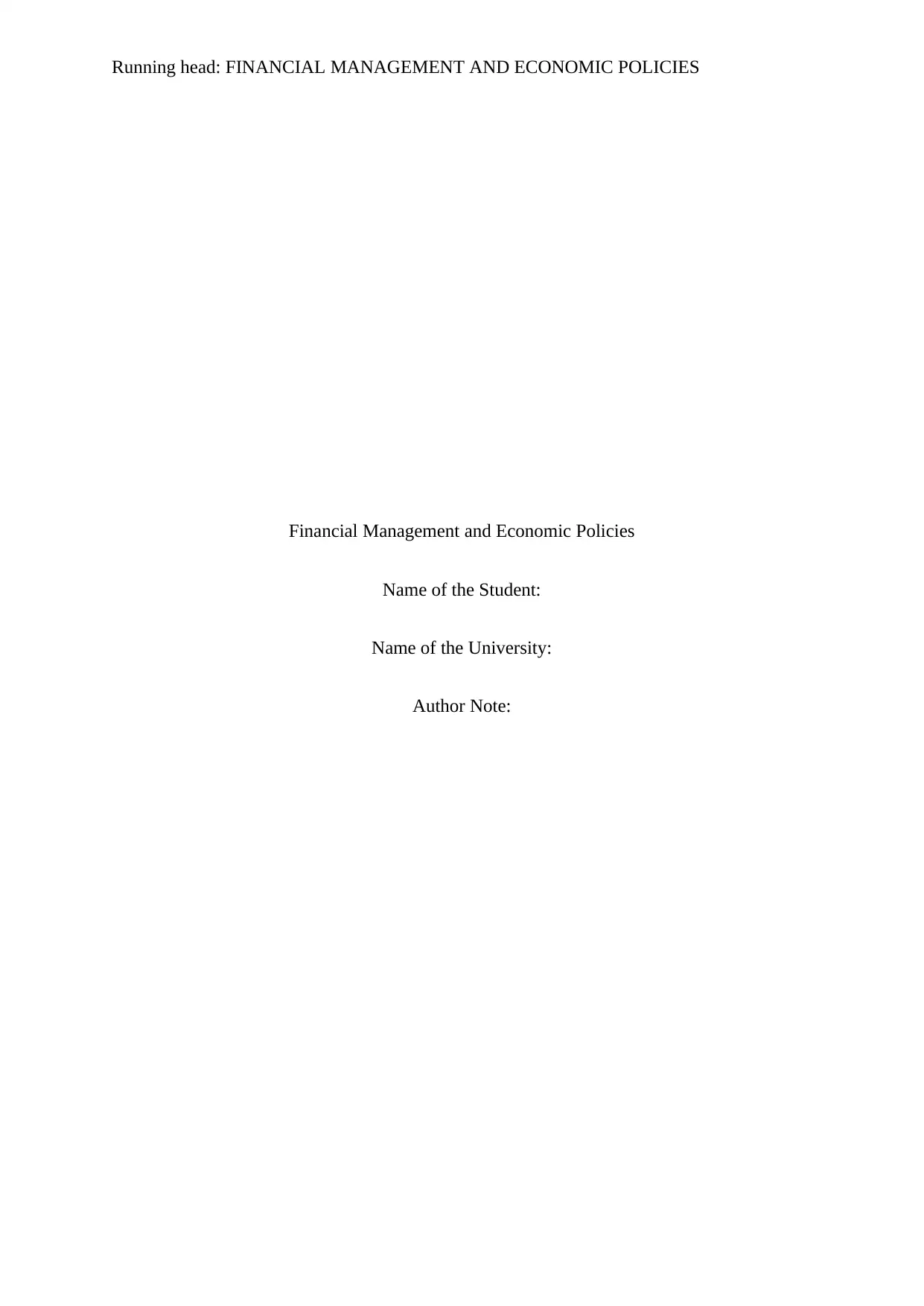
Running head: FINANCIAL MANAGEMENT AND ECONOMIC POLICIES
Financial Management and Economic Policies
Name of the Student:
Name of the University:
Author Note:
Financial Management and Economic Policies
Name of the Student:
Name of the University:
Author Note:
Secure Best Marks with AI Grader
Need help grading? Try our AI Grader for instant feedback on your assignments.
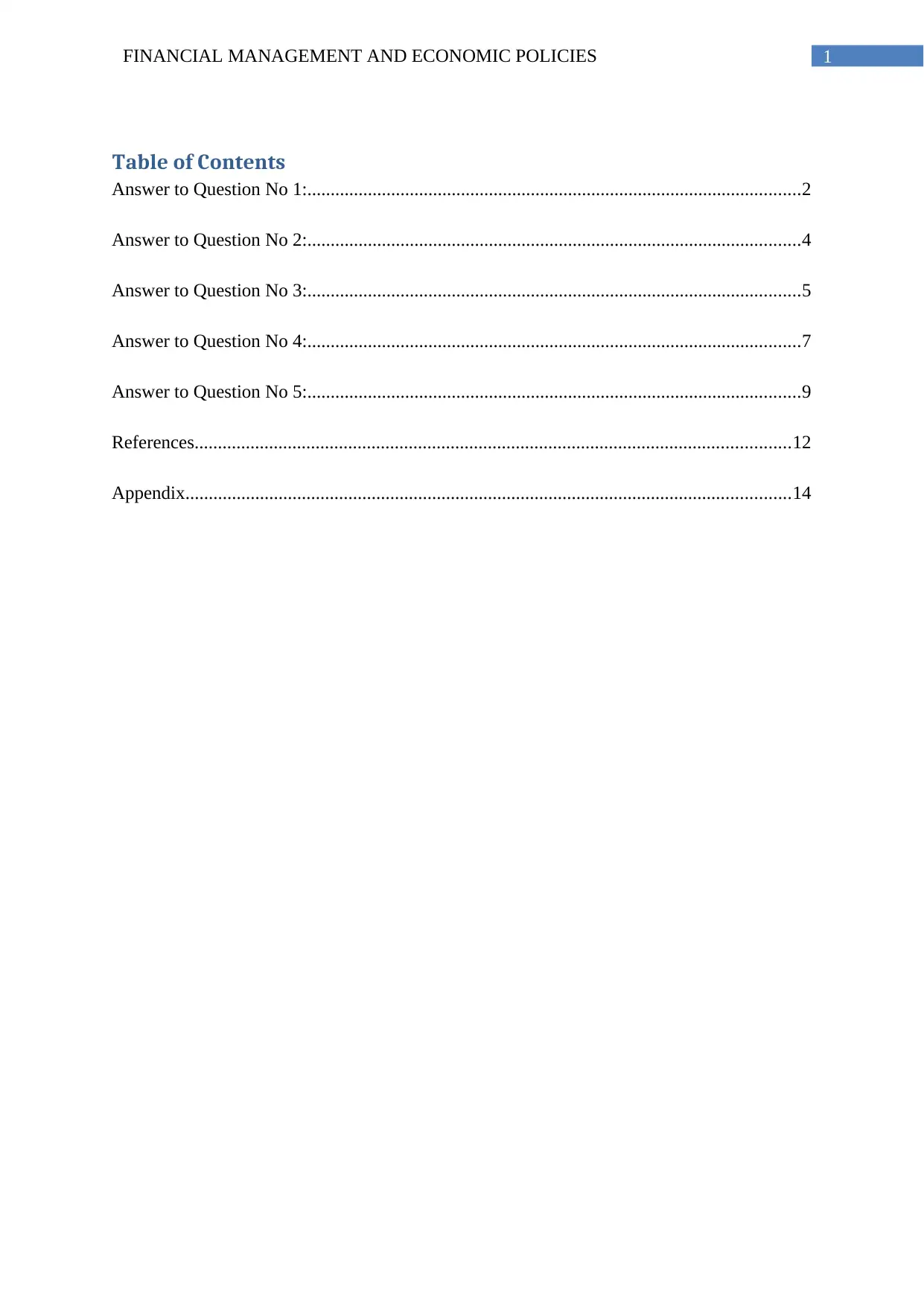
1FINANCIAL MANAGEMENT AND ECONOMIC POLICIES
Table of Contents
Answer to Question No 1:..........................................................................................................2
Answer to Question No 2:..........................................................................................................4
Answer to Question No 3:..........................................................................................................5
Answer to Question No 4:..........................................................................................................7
Answer to Question No 5:..........................................................................................................9
References................................................................................................................................12
Appendix..................................................................................................................................14
Table of Contents
Answer to Question No 1:..........................................................................................................2
Answer to Question No 2:..........................................................................................................4
Answer to Question No 3:..........................................................................................................5
Answer to Question No 4:..........................................................................................................7
Answer to Question No 5:..........................................................................................................9
References................................................................................................................................12
Appendix..................................................................................................................................14
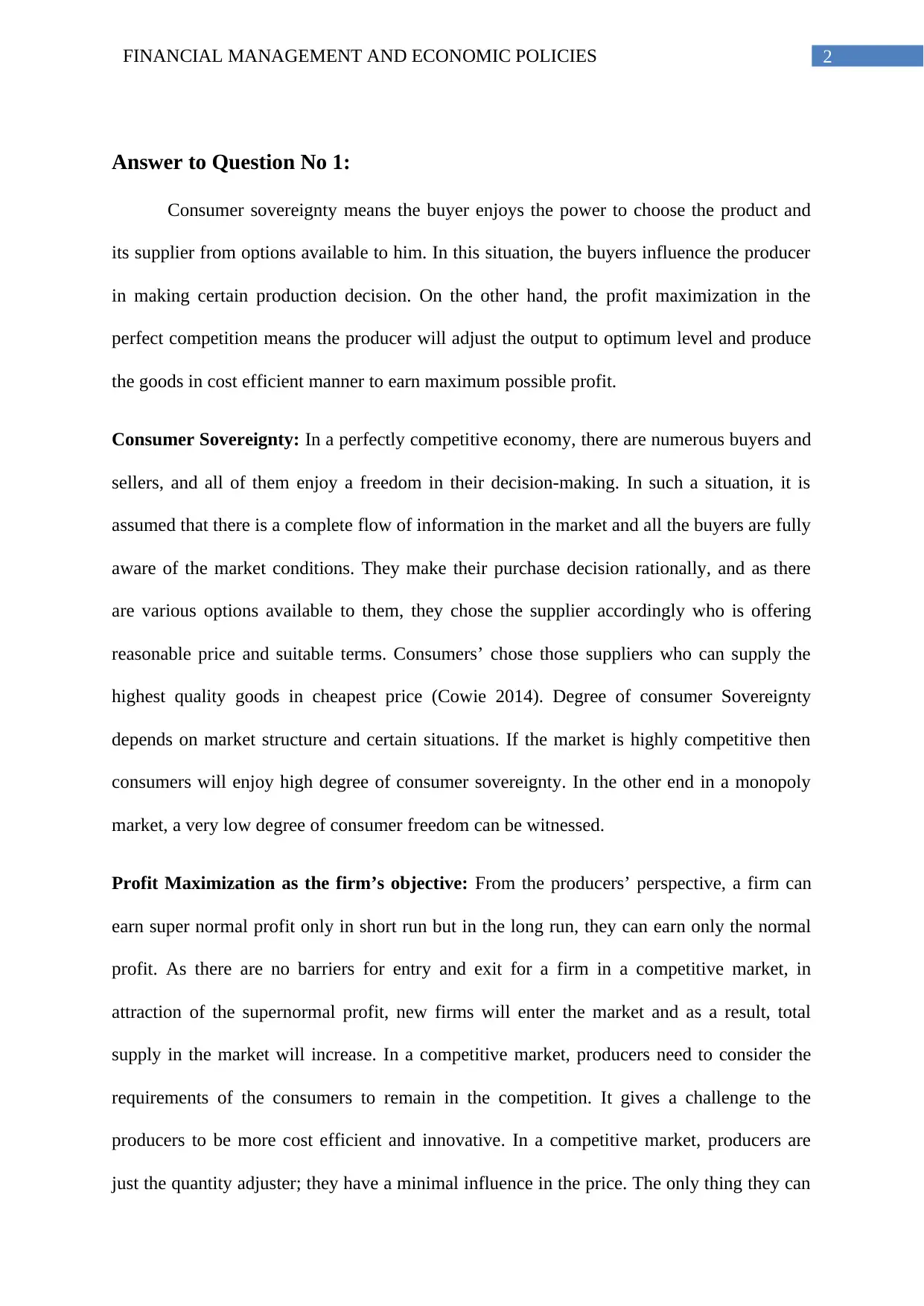
2FINANCIAL MANAGEMENT AND ECONOMIC POLICIES
Answer to Question No 1:
Consumer sovereignty means the buyer enjoys the power to choose the product and
its supplier from options available to him. In this situation, the buyers influence the producer
in making certain production decision. On the other hand, the profit maximization in the
perfect competition means the producer will adjust the output to optimum level and produce
the goods in cost efficient manner to earn maximum possible profit.
Consumer Sovereignty: In a perfectly competitive economy, there are numerous buyers and
sellers, and all of them enjoy a freedom in their decision-making. In such a situation, it is
assumed that there is a complete flow of information in the market and all the buyers are fully
aware of the market conditions. They make their purchase decision rationally, and as there
are various options available to them, they chose the supplier accordingly who is offering
reasonable price and suitable terms. Consumers’ chose those suppliers who can supply the
highest quality goods in cheapest price (Cowie 2014). Degree of consumer Sovereignty
depends on market structure and certain situations. If the market is highly competitive then
consumers will enjoy high degree of consumer sovereignty. In the other end in a monopoly
market, a very low degree of consumer freedom can be witnessed.
Profit Maximization as the firm’s objective: From the producers’ perspective, a firm can
earn super normal profit only in short run but in the long run, they can earn only the normal
profit. As there are no barriers for entry and exit for a firm in a competitive market, in
attraction of the supernormal profit, new firms will enter the market and as a result, total
supply in the market will increase. In a competitive market, producers need to consider the
requirements of the consumers to remain in the competition. It gives a challenge to the
producers to be more cost efficient and innovative. In a competitive market, producers are
just the quantity adjuster; they have a minimal influence in the price. The only thing they can
Answer to Question No 1:
Consumer sovereignty means the buyer enjoys the power to choose the product and
its supplier from options available to him. In this situation, the buyers influence the producer
in making certain production decision. On the other hand, the profit maximization in the
perfect competition means the producer will adjust the output to optimum level and produce
the goods in cost efficient manner to earn maximum possible profit.
Consumer Sovereignty: In a perfectly competitive economy, there are numerous buyers and
sellers, and all of them enjoy a freedom in their decision-making. In such a situation, it is
assumed that there is a complete flow of information in the market and all the buyers are fully
aware of the market conditions. They make their purchase decision rationally, and as there
are various options available to them, they chose the supplier accordingly who is offering
reasonable price and suitable terms. Consumers’ chose those suppliers who can supply the
highest quality goods in cheapest price (Cowie 2014). Degree of consumer Sovereignty
depends on market structure and certain situations. If the market is highly competitive then
consumers will enjoy high degree of consumer sovereignty. In the other end in a monopoly
market, a very low degree of consumer freedom can be witnessed.
Profit Maximization as the firm’s objective: From the producers’ perspective, a firm can
earn super normal profit only in short run but in the long run, they can earn only the normal
profit. As there are no barriers for entry and exit for a firm in a competitive market, in
attraction of the supernormal profit, new firms will enter the market and as a result, total
supply in the market will increase. In a competitive market, producers need to consider the
requirements of the consumers to remain in the competition. It gives a challenge to the
producers to be more cost efficient and innovative. In a competitive market, producers are
just the quantity adjuster; they have a minimal influence in the price. The only thing they can
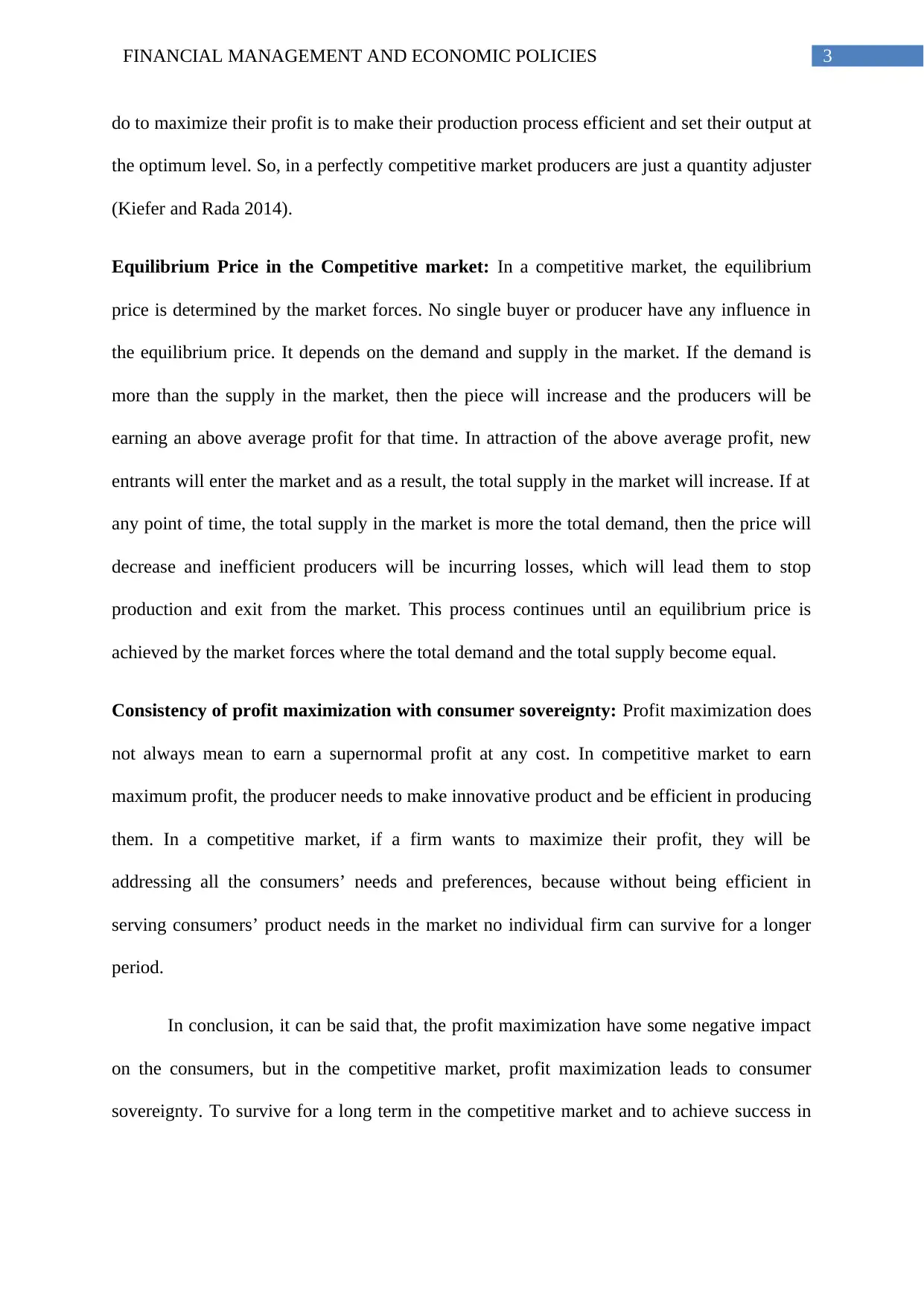
3FINANCIAL MANAGEMENT AND ECONOMIC POLICIES
do to maximize their profit is to make their production process efficient and set their output at
the optimum level. So, in a perfectly competitive market producers are just a quantity adjuster
(Kiefer and Rada 2014).
Equilibrium Price in the Competitive market: In a competitive market, the equilibrium
price is determined by the market forces. No single buyer or producer have any influence in
the equilibrium price. It depends on the demand and supply in the market. If the demand is
more than the supply in the market, then the piece will increase and the producers will be
earning an above average profit for that time. In attraction of the above average profit, new
entrants will enter the market and as a result, the total supply in the market will increase. If at
any point of time, the total supply in the market is more the total demand, then the price will
decrease and inefficient producers will be incurring losses, which will lead them to stop
production and exit from the market. This process continues until an equilibrium price is
achieved by the market forces where the total demand and the total supply become equal.
Consistency of profit maximization with consumer sovereignty: Profit maximization does
not always mean to earn a supernormal profit at any cost. In competitive market to earn
maximum profit, the producer needs to make innovative product and be efficient in producing
them. In a competitive market, if a firm wants to maximize their profit, they will be
addressing all the consumers’ needs and preferences, because without being efficient in
serving consumers’ product needs in the market no individual firm can survive for a longer
period.
In conclusion, it can be said that, the profit maximization have some negative impact
on the consumers, but in the competitive market, profit maximization leads to consumer
sovereignty. To survive for a long term in the competitive market and to achieve success in
do to maximize their profit is to make their production process efficient and set their output at
the optimum level. So, in a perfectly competitive market producers are just a quantity adjuster
(Kiefer and Rada 2014).
Equilibrium Price in the Competitive market: In a competitive market, the equilibrium
price is determined by the market forces. No single buyer or producer have any influence in
the equilibrium price. It depends on the demand and supply in the market. If the demand is
more than the supply in the market, then the piece will increase and the producers will be
earning an above average profit for that time. In attraction of the above average profit, new
entrants will enter the market and as a result, the total supply in the market will increase. If at
any point of time, the total supply in the market is more the total demand, then the price will
decrease and inefficient producers will be incurring losses, which will lead them to stop
production and exit from the market. This process continues until an equilibrium price is
achieved by the market forces where the total demand and the total supply become equal.
Consistency of profit maximization with consumer sovereignty: Profit maximization does
not always mean to earn a supernormal profit at any cost. In competitive market to earn
maximum profit, the producer needs to make innovative product and be efficient in producing
them. In a competitive market, if a firm wants to maximize their profit, they will be
addressing all the consumers’ needs and preferences, because without being efficient in
serving consumers’ product needs in the market no individual firm can survive for a longer
period.
In conclusion, it can be said that, the profit maximization have some negative impact
on the consumers, but in the competitive market, profit maximization leads to consumer
sovereignty. To survive for a long term in the competitive market and to achieve success in
Secure Best Marks with AI Grader
Need help grading? Try our AI Grader for instant feedback on your assignments.
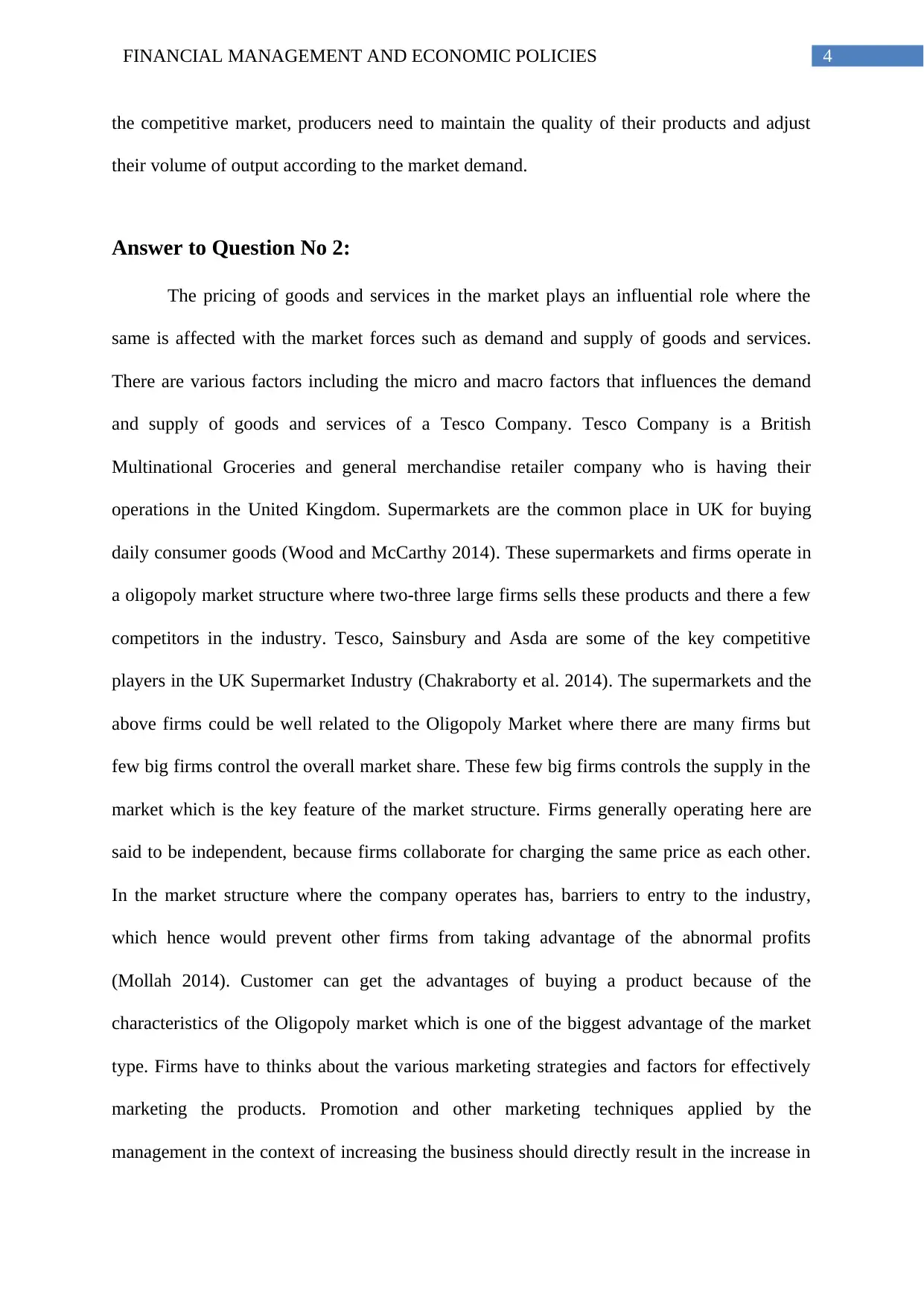
4FINANCIAL MANAGEMENT AND ECONOMIC POLICIES
the competitive market, producers need to maintain the quality of their products and adjust
their volume of output according to the market demand.
Answer to Question No 2:
The pricing of goods and services in the market plays an influential role where the
same is affected with the market forces such as demand and supply of goods and services.
There are various factors including the micro and macro factors that influences the demand
and supply of goods and services of a Tesco Company. Tesco Company is a British
Multinational Groceries and general merchandise retailer company who is having their
operations in the United Kingdom. Supermarkets are the common place in UK for buying
daily consumer goods (Wood and McCarthy 2014). These supermarkets and firms operate in
a oligopoly market structure where two-three large firms sells these products and there a few
competitors in the industry. Tesco, Sainsbury and Asda are some of the key competitive
players in the UK Supermarket Industry (Chakraborty et al. 2014). The supermarkets and the
above firms could be well related to the Oligopoly Market where there are many firms but
few big firms control the overall market share. These few big firms controls the supply in the
market which is the key feature of the market structure. Firms generally operating here are
said to be independent, because firms collaborate for charging the same price as each other.
In the market structure where the company operates has, barriers to entry to the industry,
which hence would prevent other firms from taking advantage of the abnormal profits
(Mollah 2014). Customer can get the advantages of buying a product because of the
characteristics of the Oligopoly market which is one of the biggest advantage of the market
type. Firms have to thinks about the various marketing strategies and factors for effectively
marketing the products. Promotion and other marketing techniques applied by the
management in the context of increasing the business should directly result in the increase in
the competitive market, producers need to maintain the quality of their products and adjust
their volume of output according to the market demand.
Answer to Question No 2:
The pricing of goods and services in the market plays an influential role where the
same is affected with the market forces such as demand and supply of goods and services.
There are various factors including the micro and macro factors that influences the demand
and supply of goods and services of a Tesco Company. Tesco Company is a British
Multinational Groceries and general merchandise retailer company who is having their
operations in the United Kingdom. Supermarkets are the common place in UK for buying
daily consumer goods (Wood and McCarthy 2014). These supermarkets and firms operate in
a oligopoly market structure where two-three large firms sells these products and there a few
competitors in the industry. Tesco, Sainsbury and Asda are some of the key competitive
players in the UK Supermarket Industry (Chakraborty et al. 2014). The supermarkets and the
above firms could be well related to the Oligopoly Market where there are many firms but
few big firms control the overall market share. These few big firms controls the supply in the
market which is the key feature of the market structure. Firms generally operating here are
said to be independent, because firms collaborate for charging the same price as each other.
In the market structure where the company operates has, barriers to entry to the industry,
which hence would prevent other firms from taking advantage of the abnormal profits
(Mollah 2014). Customer can get the advantages of buying a product because of the
characteristics of the Oligopoly market which is one of the biggest advantage of the market
type. Firms have to thinks about the various marketing strategies and factors for effectively
marketing the products. Promotion and other marketing techniques applied by the
management in the context of increasing the business should directly result in the increase in
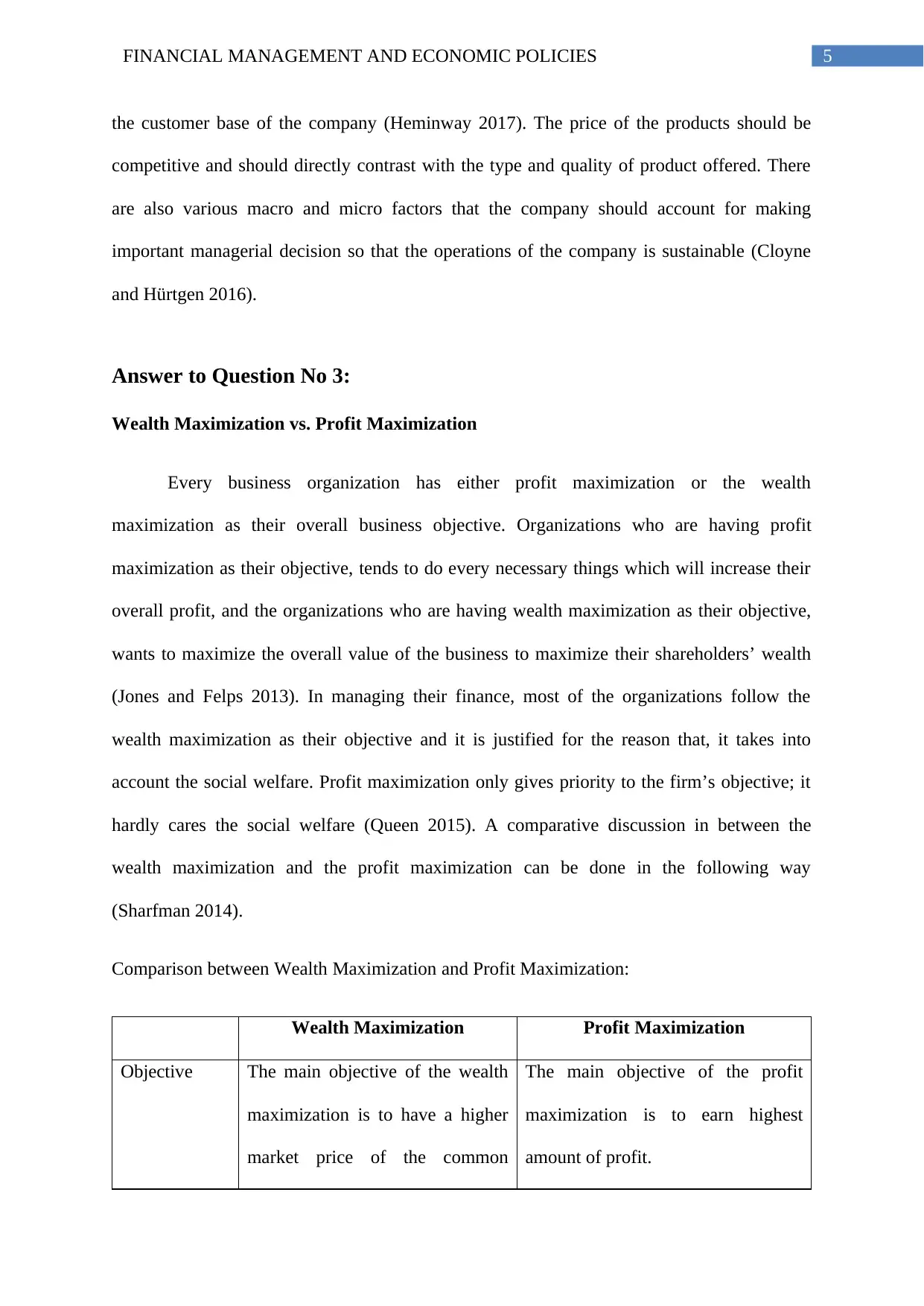
5FINANCIAL MANAGEMENT AND ECONOMIC POLICIES
the customer base of the company (Heminway 2017). The price of the products should be
competitive and should directly contrast with the type and quality of product offered. There
are also various macro and micro factors that the company should account for making
important managerial decision so that the operations of the company is sustainable (Cloyne
and Hürtgen 2016).
Answer to Question No 3:
Wealth Maximization vs. Profit Maximization
Every business organization has either profit maximization or the wealth
maximization as their overall business objective. Organizations who are having profit
maximization as their objective, tends to do every necessary things which will increase their
overall profit, and the organizations who are having wealth maximization as their objective,
wants to maximize the overall value of the business to maximize their shareholders’ wealth
(Jones and Felps 2013). In managing their finance, most of the organizations follow the
wealth maximization as their objective and it is justified for the reason that, it takes into
account the social welfare. Profit maximization only gives priority to the firm’s objective; it
hardly cares the social welfare (Queen 2015). A comparative discussion in between the
wealth maximization and the profit maximization can be done in the following way
(Sharfman 2014).
Comparison between Wealth Maximization and Profit Maximization:
Wealth Maximization Profit Maximization
Objective The main objective of the wealth
maximization is to have a higher
market price of the common
The main objective of the profit
maximization is to earn highest
amount of profit.
the customer base of the company (Heminway 2017). The price of the products should be
competitive and should directly contrast with the type and quality of product offered. There
are also various macro and micro factors that the company should account for making
important managerial decision so that the operations of the company is sustainable (Cloyne
and Hürtgen 2016).
Answer to Question No 3:
Wealth Maximization vs. Profit Maximization
Every business organization has either profit maximization or the wealth
maximization as their overall business objective. Organizations who are having profit
maximization as their objective, tends to do every necessary things which will increase their
overall profit, and the organizations who are having wealth maximization as their objective,
wants to maximize the overall value of the business to maximize their shareholders’ wealth
(Jones and Felps 2013). In managing their finance, most of the organizations follow the
wealth maximization as their objective and it is justified for the reason that, it takes into
account the social welfare. Profit maximization only gives priority to the firm’s objective; it
hardly cares the social welfare (Queen 2015). A comparative discussion in between the
wealth maximization and the profit maximization can be done in the following way
(Sharfman 2014).
Comparison between Wealth Maximization and Profit Maximization:
Wealth Maximization Profit Maximization
Objective The main objective of the wealth
maximization is to have a higher
market price of the common
The main objective of the profit
maximization is to earn highest
amount of profit.
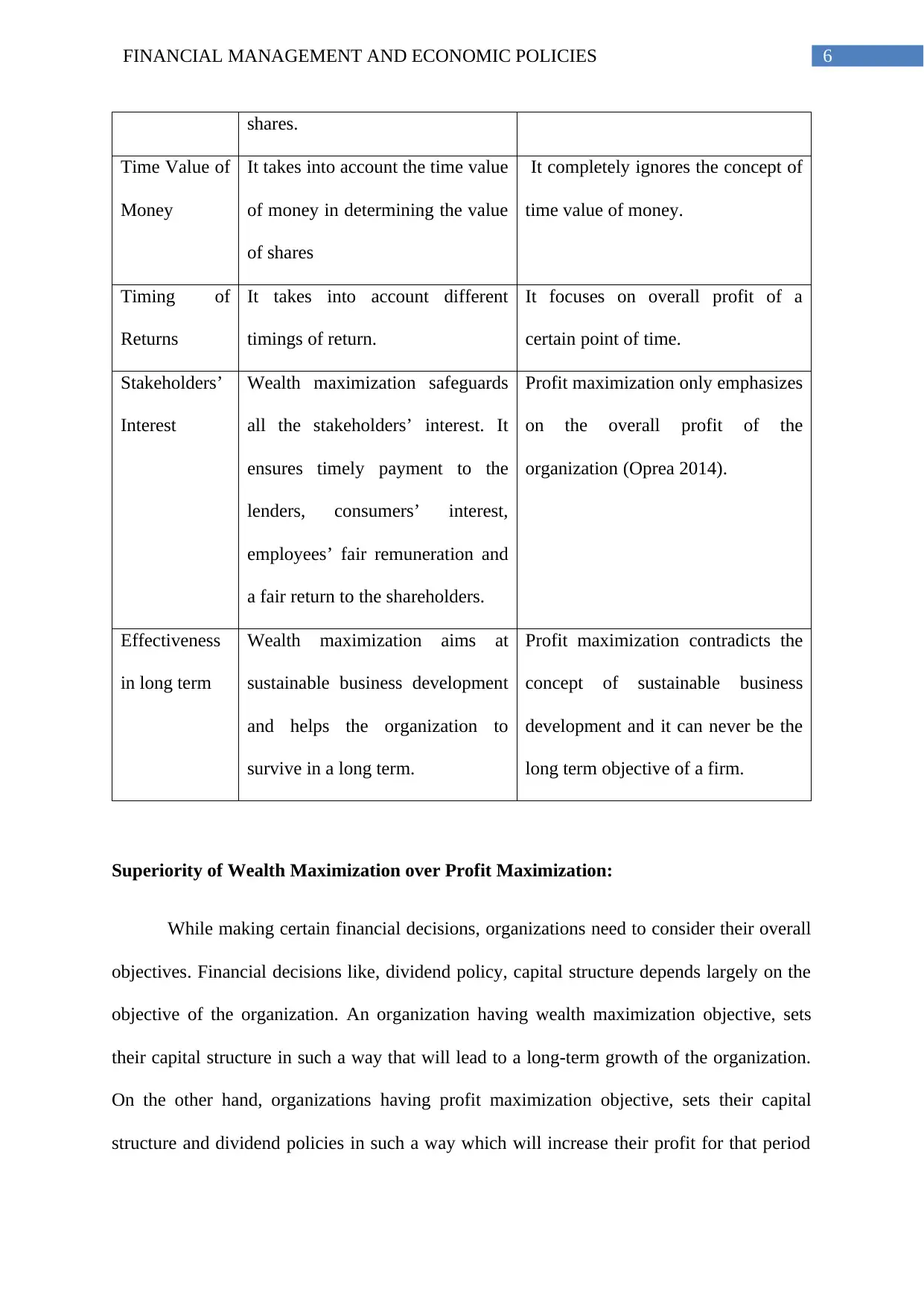
6FINANCIAL MANAGEMENT AND ECONOMIC POLICIES
shares.
Time Value of
Money
It takes into account the time value
of money in determining the value
of shares
It completely ignores the concept of
time value of money.
Timing of
Returns
It takes into account different
timings of return.
It focuses on overall profit of a
certain point of time.
Stakeholders’
Interest
Wealth maximization safeguards
all the stakeholders’ interest. It
ensures timely payment to the
lenders, consumers’ interest,
employees’ fair remuneration and
a fair return to the shareholders.
Profit maximization only emphasizes
on the overall profit of the
organization (Oprea 2014).
Effectiveness
in long term
Wealth maximization aims at
sustainable business development
and helps the organization to
survive in a long term.
Profit maximization contradicts the
concept of sustainable business
development and it can never be the
long term objective of a firm.
Superiority of Wealth Maximization over Profit Maximization:
While making certain financial decisions, organizations need to consider their overall
objectives. Financial decisions like, dividend policy, capital structure depends largely on the
objective of the organization. An organization having wealth maximization objective, sets
their capital structure in such a way that will lead to a long-term growth of the organization.
On the other hand, organizations having profit maximization objective, sets their capital
structure and dividend policies in such a way which will increase their profit for that period
shares.
Time Value of
Money
It takes into account the time value
of money in determining the value
of shares
It completely ignores the concept of
time value of money.
Timing of
Returns
It takes into account different
timings of return.
It focuses on overall profit of a
certain point of time.
Stakeholders’
Interest
Wealth maximization safeguards
all the stakeholders’ interest. It
ensures timely payment to the
lenders, consumers’ interest,
employees’ fair remuneration and
a fair return to the shareholders.
Profit maximization only emphasizes
on the overall profit of the
organization (Oprea 2014).
Effectiveness
in long term
Wealth maximization aims at
sustainable business development
and helps the organization to
survive in a long term.
Profit maximization contradicts the
concept of sustainable business
development and it can never be the
long term objective of a firm.
Superiority of Wealth Maximization over Profit Maximization:
While making certain financial decisions, organizations need to consider their overall
objectives. Financial decisions like, dividend policy, capital structure depends largely on the
objective of the organization. An organization having wealth maximization objective, sets
their capital structure in such a way that will lead to a long-term growth of the organization.
On the other hand, organizations having profit maximization objective, sets their capital
structure and dividend policies in such a way which will increase their profit for that period
Paraphrase This Document
Need a fresh take? Get an instant paraphrase of this document with our AI Paraphraser
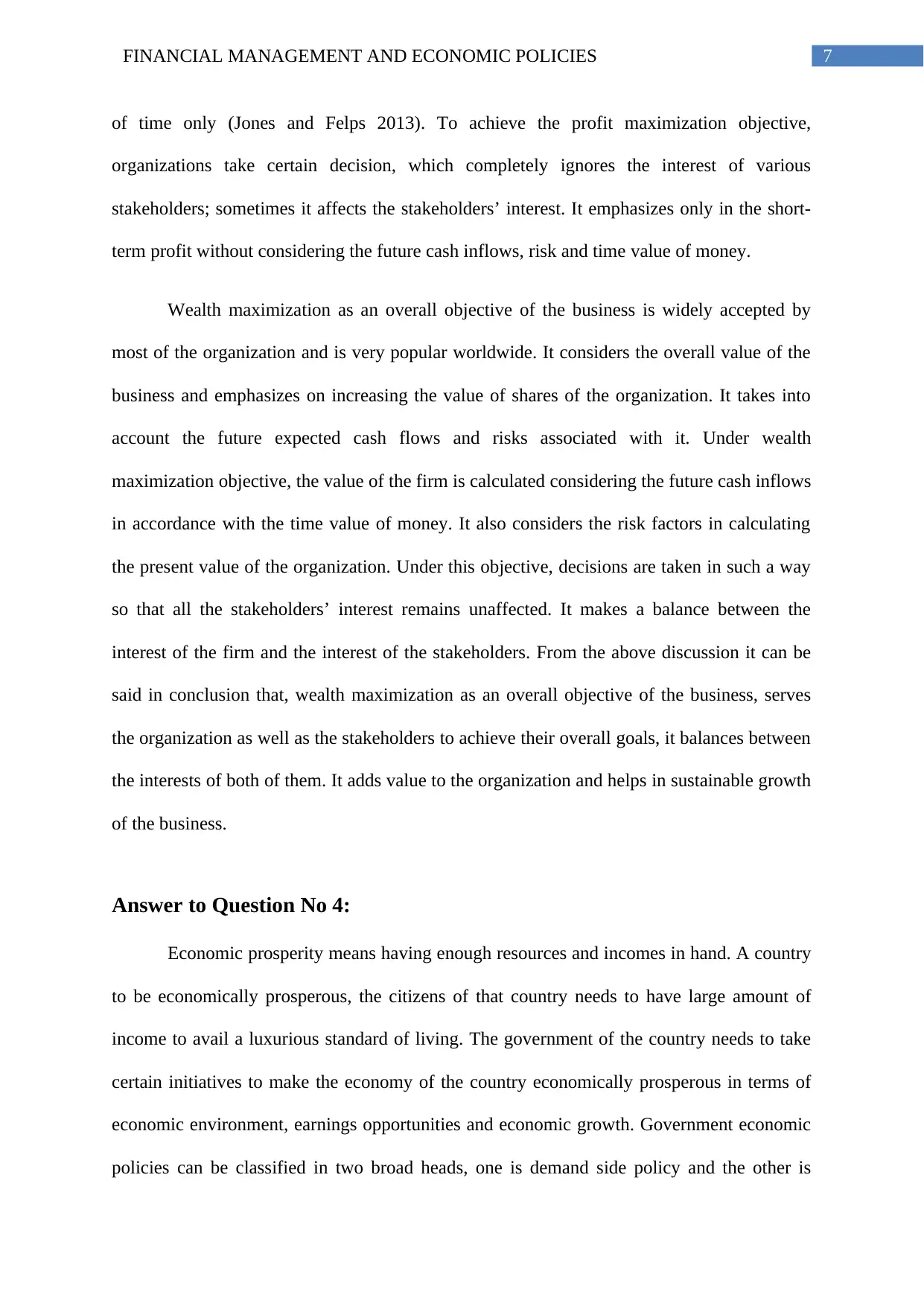
7FINANCIAL MANAGEMENT AND ECONOMIC POLICIES
of time only (Jones and Felps 2013). To achieve the profit maximization objective,
organizations take certain decision, which completely ignores the interest of various
stakeholders; sometimes it affects the stakeholders’ interest. It emphasizes only in the short-
term profit without considering the future cash inflows, risk and time value of money.
Wealth maximization as an overall objective of the business is widely accepted by
most of the organization and is very popular worldwide. It considers the overall value of the
business and emphasizes on increasing the value of shares of the organization. It takes into
account the future expected cash flows and risks associated with it. Under wealth
maximization objective, the value of the firm is calculated considering the future cash inflows
in accordance with the time value of money. It also considers the risk factors in calculating
the present value of the organization. Under this objective, decisions are taken in such a way
so that all the stakeholders’ interest remains unaffected. It makes a balance between the
interest of the firm and the interest of the stakeholders. From the above discussion it can be
said in conclusion that, wealth maximization as an overall objective of the business, serves
the organization as well as the stakeholders to achieve their overall goals, it balances between
the interests of both of them. It adds value to the organization and helps in sustainable growth
of the business.
Answer to Question No 4:
Economic prosperity means having enough resources and incomes in hand. A country
to be economically prosperous, the citizens of that country needs to have large amount of
income to avail a luxurious standard of living. The government of the country needs to take
certain initiatives to make the economy of the country economically prosperous in terms of
economic environment, earnings opportunities and economic growth. Government economic
policies can be classified in two broad heads, one is demand side policy and the other is
of time only (Jones and Felps 2013). To achieve the profit maximization objective,
organizations take certain decision, which completely ignores the interest of various
stakeholders; sometimes it affects the stakeholders’ interest. It emphasizes only in the short-
term profit without considering the future cash inflows, risk and time value of money.
Wealth maximization as an overall objective of the business is widely accepted by
most of the organization and is very popular worldwide. It considers the overall value of the
business and emphasizes on increasing the value of shares of the organization. It takes into
account the future expected cash flows and risks associated with it. Under wealth
maximization objective, the value of the firm is calculated considering the future cash inflows
in accordance with the time value of money. It also considers the risk factors in calculating
the present value of the organization. Under this objective, decisions are taken in such a way
so that all the stakeholders’ interest remains unaffected. It makes a balance between the
interest of the firm and the interest of the stakeholders. From the above discussion it can be
said in conclusion that, wealth maximization as an overall objective of the business, serves
the organization as well as the stakeholders to achieve their overall goals, it balances between
the interests of both of them. It adds value to the organization and helps in sustainable growth
of the business.
Answer to Question No 4:
Economic prosperity means having enough resources and incomes in hand. A country
to be economically prosperous, the citizens of that country needs to have large amount of
income to avail a luxurious standard of living. The government of the country needs to take
certain initiatives to make the economy of the country economically prosperous in terms of
economic environment, earnings opportunities and economic growth. Government economic
policies can be classified in two broad heads, one is demand side policy and the other is
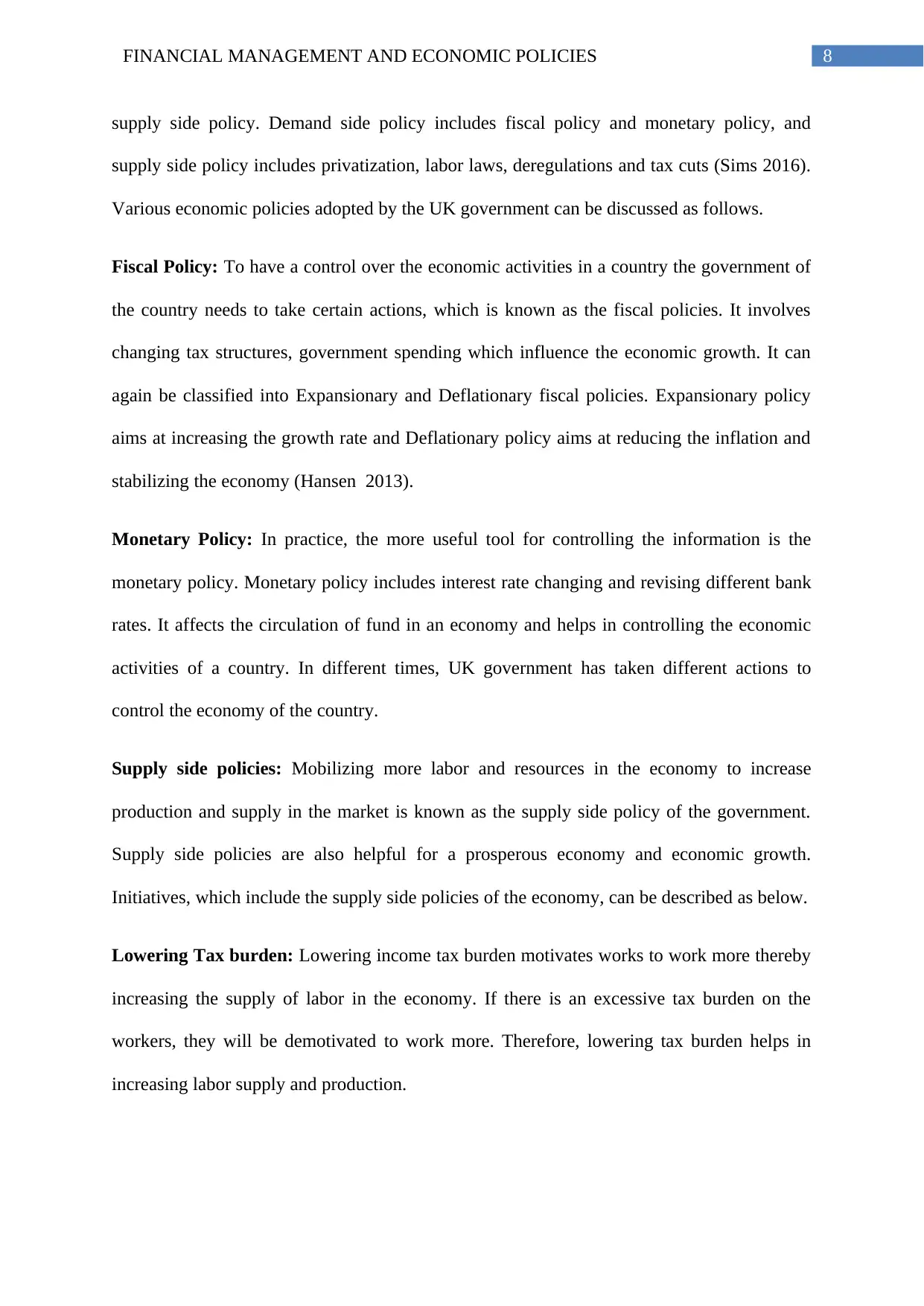
8FINANCIAL MANAGEMENT AND ECONOMIC POLICIES
supply side policy. Demand side policy includes fiscal policy and monetary policy, and
supply side policy includes privatization, labor laws, deregulations and tax cuts (Sims 2016).
Various economic policies adopted by the UK government can be discussed as follows.
Fiscal Policy: To have a control over the economic activities in a country the government of
the country needs to take certain actions, which is known as the fiscal policies. It involves
changing tax structures, government spending which influence the economic growth. It can
again be classified into Expansionary and Deflationary fiscal policies. Expansionary policy
aims at increasing the growth rate and Deflationary policy aims at reducing the inflation and
stabilizing the economy (Hansen 2013).
Monetary Policy: In practice, the more useful tool for controlling the information is the
monetary policy. Monetary policy includes interest rate changing and revising different bank
rates. It affects the circulation of fund in an economy and helps in controlling the economic
activities of a country. In different times, UK government has taken different actions to
control the economy of the country.
Supply side policies: Mobilizing more labor and resources in the economy to increase
production and supply in the market is known as the supply side policy of the government.
Supply side policies are also helpful for a prosperous economy and economic growth.
Initiatives, which include the supply side policies of the economy, can be described as below.
Lowering Tax burden: Lowering income tax burden motivates works to work more thereby
increasing the supply of labor in the economy. If there is an excessive tax burden on the
workers, they will be demotivated to work more. Therefore, lowering tax burden helps in
increasing labor supply and production.
supply side policy. Demand side policy includes fiscal policy and monetary policy, and
supply side policy includes privatization, labor laws, deregulations and tax cuts (Sims 2016).
Various economic policies adopted by the UK government can be discussed as follows.
Fiscal Policy: To have a control over the economic activities in a country the government of
the country needs to take certain actions, which is known as the fiscal policies. It involves
changing tax structures, government spending which influence the economic growth. It can
again be classified into Expansionary and Deflationary fiscal policies. Expansionary policy
aims at increasing the growth rate and Deflationary policy aims at reducing the inflation and
stabilizing the economy (Hansen 2013).
Monetary Policy: In practice, the more useful tool for controlling the information is the
monetary policy. Monetary policy includes interest rate changing and revising different bank
rates. It affects the circulation of fund in an economy and helps in controlling the economic
activities of a country. In different times, UK government has taken different actions to
control the economy of the country.
Supply side policies: Mobilizing more labor and resources in the economy to increase
production and supply in the market is known as the supply side policy of the government.
Supply side policies are also helpful for a prosperous economy and economic growth.
Initiatives, which include the supply side policies of the economy, can be described as below.
Lowering Tax burden: Lowering income tax burden motivates works to work more thereby
increasing the supply of labor in the economy. If there is an excessive tax burden on the
workers, they will be demotivated to work more. Therefore, lowering tax burden helps in
increasing labor supply and production.

9FINANCIAL MANAGEMENT AND ECONOMIC POLICIES
Flexibility in the Labor Market: Labor market must be flexible and there must be complete
flow or mobility of the workforce. It means labor must be available as and when needed and
in place where it is needed.
Privatization: Privatization of manufacturing units also helps in efficient production and in
increasing supply of products in the market. UK first experimented the privatization in the
period 1979-81 and from then the government still now emphasize on privatization as a
supply side policy to support the economy.
Union Relationships: Labor unions always have some effect on the labor forces of the
country. In UK also in the initial stages, there was no such positive influence of the labor
unions, which could have helped the labors and the producers. Later on with certain initiative
by the UK government to increase the positive relationships between the trade union and the
management, government was able to strengthen the productive workforce in the UK.
Environmental Policies: Business organizations are some social establishment, which
operates in the society to serve the needs of the society. Government should take such
initiatives, which will help in sustainable development of the environment, so that the
business organizations also have a sustainable growth in a suitable business environment.
Various government initiatives by the UK government achieved a 1.4% GDP growth
in the year 2018, and per capita GDP was $42,616 in the year 2018 including many other
government policies, which helped the country to achieve a prosperous economy
(countryeconomy.com 2019). In conclusion, it can be said that, government should take
certain policies time to time to control the economy to achieve a prosperous and sustainable
economic growth.
Flexibility in the Labor Market: Labor market must be flexible and there must be complete
flow or mobility of the workforce. It means labor must be available as and when needed and
in place where it is needed.
Privatization: Privatization of manufacturing units also helps in efficient production and in
increasing supply of products in the market. UK first experimented the privatization in the
period 1979-81 and from then the government still now emphasize on privatization as a
supply side policy to support the economy.
Union Relationships: Labor unions always have some effect on the labor forces of the
country. In UK also in the initial stages, there was no such positive influence of the labor
unions, which could have helped the labors and the producers. Later on with certain initiative
by the UK government to increase the positive relationships between the trade union and the
management, government was able to strengthen the productive workforce in the UK.
Environmental Policies: Business organizations are some social establishment, which
operates in the society to serve the needs of the society. Government should take such
initiatives, which will help in sustainable development of the environment, so that the
business organizations also have a sustainable growth in a suitable business environment.
Various government initiatives by the UK government achieved a 1.4% GDP growth
in the year 2018, and per capita GDP was $42,616 in the year 2018 including many other
government policies, which helped the country to achieve a prosperous economy
(countryeconomy.com 2019). In conclusion, it can be said that, government should take
certain policies time to time to control the economy to achieve a prosperous and sustainable
economic growth.
Secure Best Marks with AI Grader
Need help grading? Try our AI Grader for instant feedback on your assignments.

10FINANCIAL MANAGEMENT AND ECONOMIC POLICIES
Answer to Question No 5:
a) Ratio Analysis
b) The lump sum amount which needs to be deposited by Adams instead of the £ 105 in the
three years of course time would be £ 2,380 which would be the lump sum amount that would
be paid by Adams (Appendix 1).
Particulars Year 2017 Year 2018
Current Assets 3277 2460
Current Liabilities 2568 1794
(Current Assets/Current Liabilities) =B4/B5 =C4/C5
Current Ratio 1.276090343 1.371237458
Cash and Cash Equivalents 61 55
Investments 798 252
Accounts Receivables (Debtors) 2168 1945
Current Liabilities 2568 1794
(Cash+Investment+Accounts Receivable/Current Liability) =SUM(B9:B11)/B12 =SUM(C9:C11)/C12
Quick Ratio 1.178738318 1.255295429
Debtors 2168 1945
Sales Turnover 7653 6876
(Debtors/Sales)*365 =(B16/B17)*365 =(C16/C17)*365
Debtors Payment Period 103.3999739 103.2468005
Sales 7653 6876
Inventory 250 208
(Sales/Inventory) =B21/B22 =C21/C22
Inventory Turnover Ratio 30.612 33.05769231
Days in Year 365 365
Inventory Turnover Ratio 30.612 33.05769231
(Days in Year/ Inventory Turnover Ratio) =B26/B27 =C26/C27
Stock Turnover Period 11.92342872 11.04130308
Ratio Analysis of Zenobia Ltd Accounts
Answer to Question No 5:
a) Ratio Analysis
b) The lump sum amount which needs to be deposited by Adams instead of the £ 105 in the
three years of course time would be £ 2,380 which would be the lump sum amount that would
be paid by Adams (Appendix 1).
Particulars Year 2017 Year 2018
Current Assets 3277 2460
Current Liabilities 2568 1794
(Current Assets/Current Liabilities) =B4/B5 =C4/C5
Current Ratio 1.276090343 1.371237458
Cash and Cash Equivalents 61 55
Investments 798 252
Accounts Receivables (Debtors) 2168 1945
Current Liabilities 2568 1794
(Cash+Investment+Accounts Receivable/Current Liability) =SUM(B9:B11)/B12 =SUM(C9:C11)/C12
Quick Ratio 1.178738318 1.255295429
Debtors 2168 1945
Sales Turnover 7653 6876
(Debtors/Sales)*365 =(B16/B17)*365 =(C16/C17)*365
Debtors Payment Period 103.3999739 103.2468005
Sales 7653 6876
Inventory 250 208
(Sales/Inventory) =B21/B22 =C21/C22
Inventory Turnover Ratio 30.612 33.05769231
Days in Year 365 365
Inventory Turnover Ratio 30.612 33.05769231
(Days in Year/ Inventory Turnover Ratio) =B26/B27 =C26/C27
Stock Turnover Period 11.92342872 11.04130308
Ratio Analysis of Zenobia Ltd Accounts
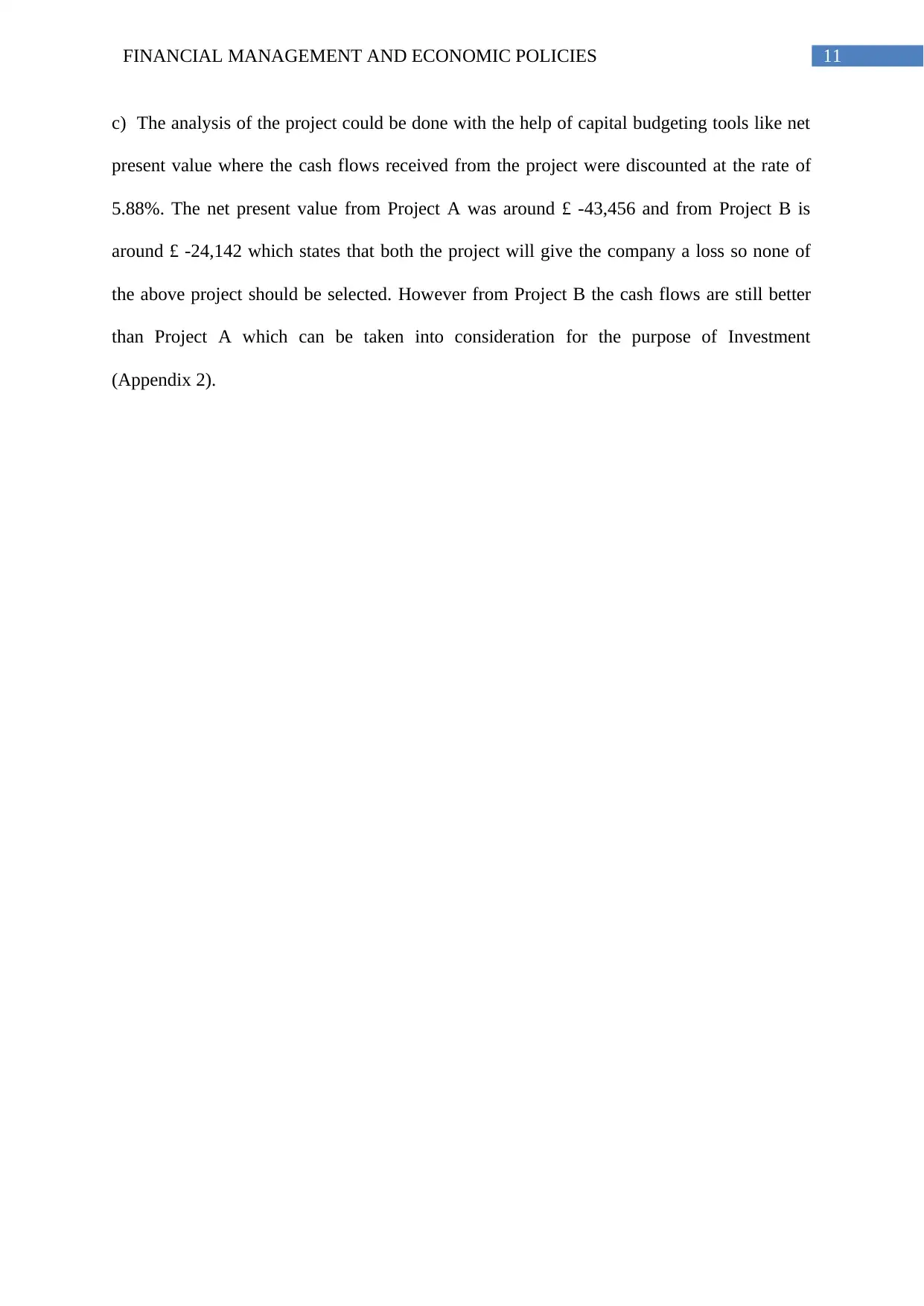
11FINANCIAL MANAGEMENT AND ECONOMIC POLICIES
c) The analysis of the project could be done with the help of capital budgeting tools like net
present value where the cash flows received from the project were discounted at the rate of
5.88%. The net present value from Project A was around £ -43,456 and from Project B is
around £ -24,142 which states that both the project will give the company a loss so none of
the above project should be selected. However from Project B the cash flows are still better
than Project A which can be taken into consideration for the purpose of Investment
(Appendix 2).
c) The analysis of the project could be done with the help of capital budgeting tools like net
present value where the cash flows received from the project were discounted at the rate of
5.88%. The net present value from Project A was around £ -43,456 and from Project B is
around £ -24,142 which states that both the project will give the company a loss so none of
the above project should be selected. However from Project B the cash flows are still better
than Project A which can be taken into consideration for the purpose of Investment
(Appendix 2).
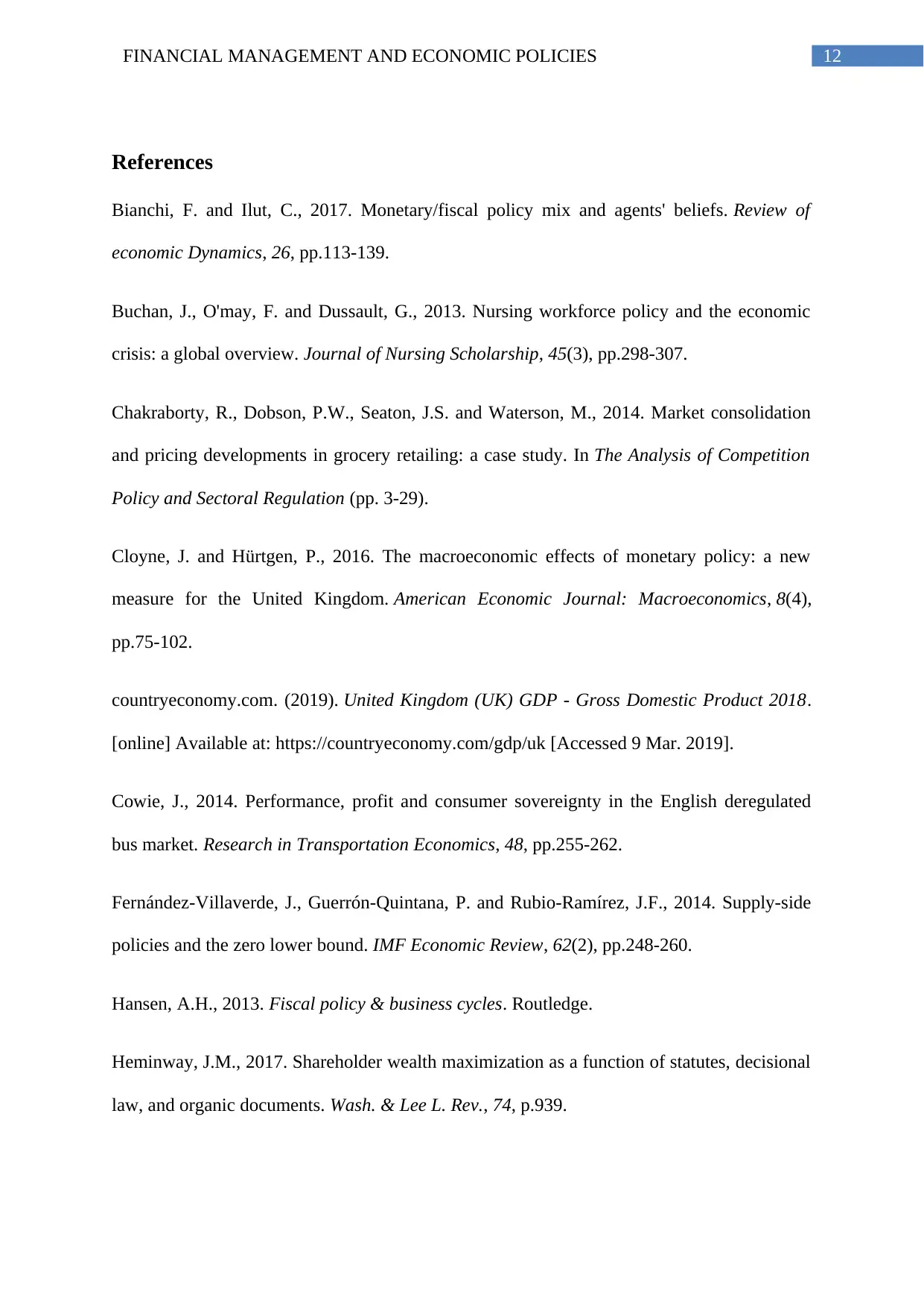
12FINANCIAL MANAGEMENT AND ECONOMIC POLICIES
References
Bianchi, F. and Ilut, C., 2017. Monetary/fiscal policy mix and agents' beliefs. Review of
economic Dynamics, 26, pp.113-139.
Buchan, J., O'may, F. and Dussault, G., 2013. Nursing workforce policy and the economic
crisis: a global overview. Journal of Nursing Scholarship, 45(3), pp.298-307.
Chakraborty, R., Dobson, P.W., Seaton, J.S. and Waterson, M., 2014. Market consolidation
and pricing developments in grocery retailing: a case study. In The Analysis of Competition
Policy and Sectoral Regulation (pp. 3-29).
Cloyne, J. and Hürtgen, P., 2016. The macroeconomic effects of monetary policy: a new
measure for the United Kingdom. American Economic Journal: Macroeconomics, 8(4),
pp.75-102.
countryeconomy.com. (2019). United Kingdom (UK) GDP - Gross Domestic Product 2018.
[online] Available at: https://countryeconomy.com/gdp/uk [Accessed 9 Mar. 2019].
Cowie, J., 2014. Performance, profit and consumer sovereignty in the English deregulated
bus market. Research in Transportation Economics, 48, pp.255-262.
Fernández-Villaverde, J., Guerrón-Quintana, P. and Rubio-Ramírez, J.F., 2014. Supply-side
policies and the zero lower bound. IMF Economic Review, 62(2), pp.248-260.
Hansen, A.H., 2013. Fiscal policy & business cycles. Routledge.
Heminway, J.M., 2017. Shareholder wealth maximization as a function of statutes, decisional
law, and organic documents. Wash. & Lee L. Rev., 74, p.939.
References
Bianchi, F. and Ilut, C., 2017. Monetary/fiscal policy mix and agents' beliefs. Review of
economic Dynamics, 26, pp.113-139.
Buchan, J., O'may, F. and Dussault, G., 2013. Nursing workforce policy and the economic
crisis: a global overview. Journal of Nursing Scholarship, 45(3), pp.298-307.
Chakraborty, R., Dobson, P.W., Seaton, J.S. and Waterson, M., 2014. Market consolidation
and pricing developments in grocery retailing: a case study. In The Analysis of Competition
Policy and Sectoral Regulation (pp. 3-29).
Cloyne, J. and Hürtgen, P., 2016. The macroeconomic effects of monetary policy: a new
measure for the United Kingdom. American Economic Journal: Macroeconomics, 8(4),
pp.75-102.
countryeconomy.com. (2019). United Kingdom (UK) GDP - Gross Domestic Product 2018.
[online] Available at: https://countryeconomy.com/gdp/uk [Accessed 9 Mar. 2019].
Cowie, J., 2014. Performance, profit and consumer sovereignty in the English deregulated
bus market. Research in Transportation Economics, 48, pp.255-262.
Fernández-Villaverde, J., Guerrón-Quintana, P. and Rubio-Ramírez, J.F., 2014. Supply-side
policies and the zero lower bound. IMF Economic Review, 62(2), pp.248-260.
Hansen, A.H., 2013. Fiscal policy & business cycles. Routledge.
Heminway, J.M., 2017. Shareholder wealth maximization as a function of statutes, decisional
law, and organic documents. Wash. & Lee L. Rev., 74, p.939.
Paraphrase This Document
Need a fresh take? Get an instant paraphrase of this document with our AI Paraphraser
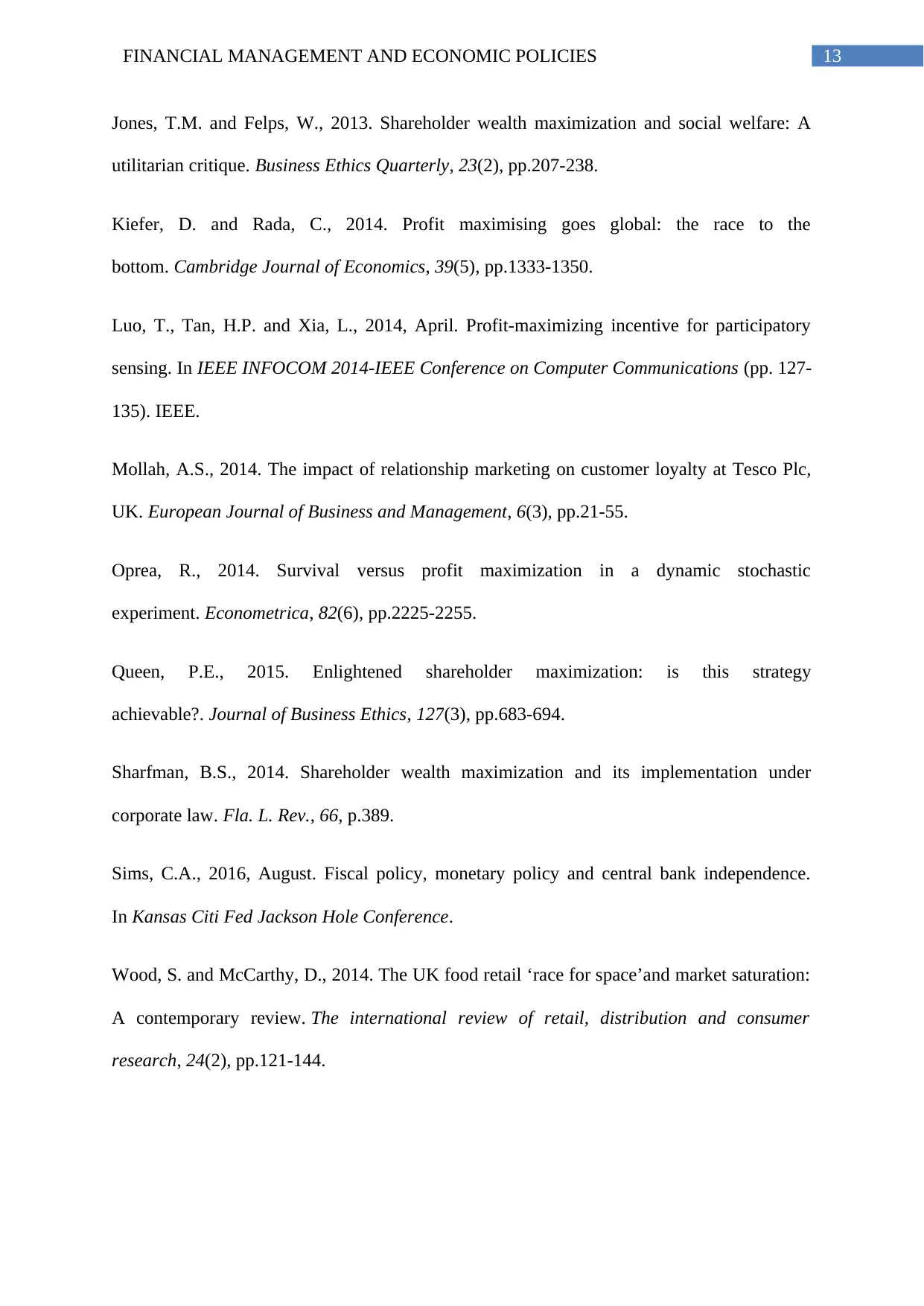
13FINANCIAL MANAGEMENT AND ECONOMIC POLICIES
Jones, T.M. and Felps, W., 2013. Shareholder wealth maximization and social welfare: A
utilitarian critique. Business Ethics Quarterly, 23(2), pp.207-238.
Kiefer, D. and Rada, C., 2014. Profit maximising goes global: the race to the
bottom. Cambridge Journal of Economics, 39(5), pp.1333-1350.
Luo, T., Tan, H.P. and Xia, L., 2014, April. Profit-maximizing incentive for participatory
sensing. In IEEE INFOCOM 2014-IEEE Conference on Computer Communications (pp. 127-
135). IEEE.
Mollah, A.S., 2014. The impact of relationship marketing on customer loyalty at Tesco Plc,
UK. European Journal of Business and Management, 6(3), pp.21-55.
Oprea, R., 2014. Survival versus profit maximization in a dynamic stochastic
experiment. Econometrica, 82(6), pp.2225-2255.
Queen, P.E., 2015. Enlightened shareholder maximization: is this strategy
achievable?. Journal of Business Ethics, 127(3), pp.683-694.
Sharfman, B.S., 2014. Shareholder wealth maximization and its implementation under
corporate law. Fla. L. Rev., 66, p.389.
Sims, C.A., 2016, August. Fiscal policy, monetary policy and central bank independence.
In Kansas Citi Fed Jackson Hole Conference.
Wood, S. and McCarthy, D., 2014. The UK food retail ‘race for space’and market saturation:
A contemporary review. The international review of retail, distribution and consumer
research, 24(2), pp.121-144.
Jones, T.M. and Felps, W., 2013. Shareholder wealth maximization and social welfare: A
utilitarian critique. Business Ethics Quarterly, 23(2), pp.207-238.
Kiefer, D. and Rada, C., 2014. Profit maximising goes global: the race to the
bottom. Cambridge Journal of Economics, 39(5), pp.1333-1350.
Luo, T., Tan, H.P. and Xia, L., 2014, April. Profit-maximizing incentive for participatory
sensing. In IEEE INFOCOM 2014-IEEE Conference on Computer Communications (pp. 127-
135). IEEE.
Mollah, A.S., 2014. The impact of relationship marketing on customer loyalty at Tesco Plc,
UK. European Journal of Business and Management, 6(3), pp.21-55.
Oprea, R., 2014. Survival versus profit maximization in a dynamic stochastic
experiment. Econometrica, 82(6), pp.2225-2255.
Queen, P.E., 2015. Enlightened shareholder maximization: is this strategy
achievable?. Journal of Business Ethics, 127(3), pp.683-694.
Sharfman, B.S., 2014. Shareholder wealth maximization and its implementation under
corporate law. Fla. L. Rev., 66, p.389.
Sims, C.A., 2016, August. Fiscal policy, monetary policy and central bank independence.
In Kansas Citi Fed Jackson Hole Conference.
Wood, S. and McCarthy, D., 2014. The UK food retail ‘race for space’and market saturation:
A contemporary review. The international review of retail, distribution and consumer
research, 24(2), pp.121-144.
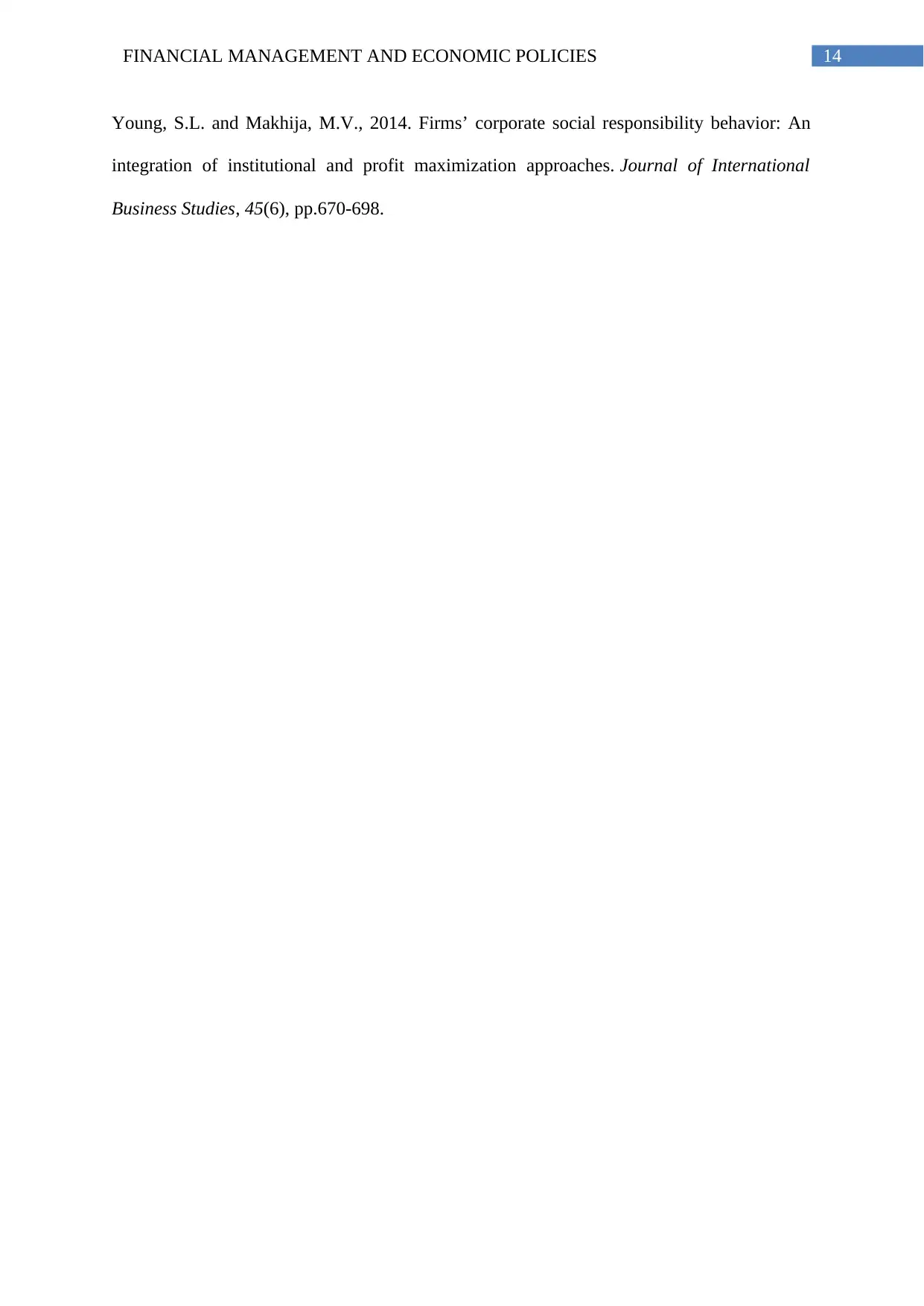
14FINANCIAL MANAGEMENT AND ECONOMIC POLICIES
Young, S.L. and Makhija, M.V., 2014. Firms’ corporate social responsibility behavior: An
integration of institutional and profit maximization approaches. Journal of International
Business Studies, 45(6), pp.670-698.
Young, S.L. and Makhija, M.V., 2014. Firms’ corporate social responsibility behavior: An
integration of institutional and profit maximization approaches. Journal of International
Business Studies, 45(6), pp.670-698.
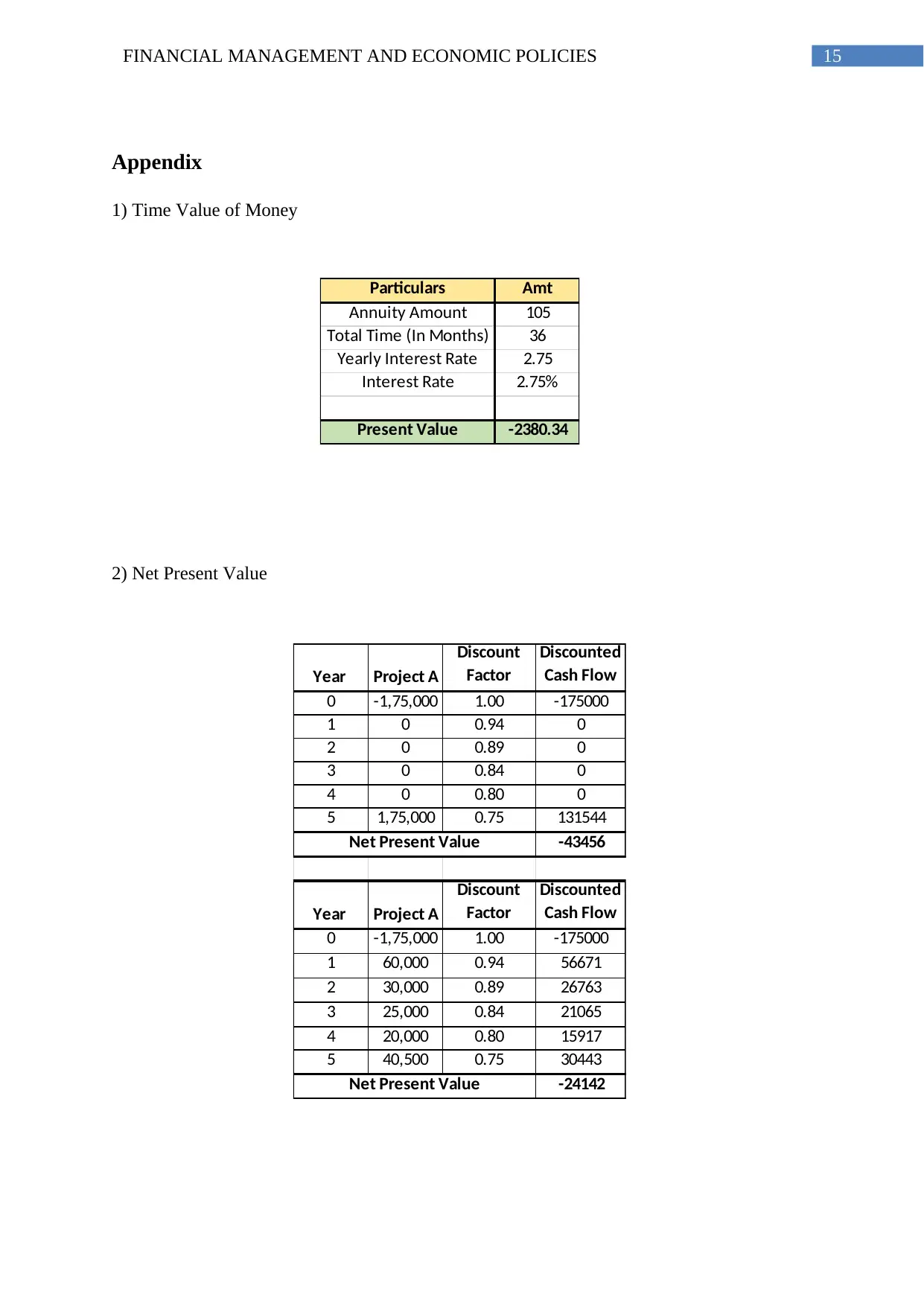
15FINANCIAL MANAGEMENT AND ECONOMIC POLICIES
Appendix
1) Time Value of Money
2) Net Present Value
Particulars Amt
Annuity Amount 105
Total Time (In Months) 36
Yearly Interest Rate 2.75
Interest Rate 2.75%
Present Value -2380.34
Year Project A
Discount
Factor
Discounted
Cash Flow
0 -1,75,000 1.00 -175000
1 0 0.94 0
2 0 0.89 0
3 0 0.84 0
4 0 0.80 0
5 1,75,000 0.75 131544
-43456
Year Project A
Discount
Factor
Discounted
Cash Flow
0 -1,75,000 1.00 -175000
1 60,000 0.94 56671
2 30,000 0.89 26763
3 25,000 0.84 21065
4 20,000 0.80 15917
5 40,500 0.75 30443
-24142
Net Present Value
Net Present Value
Appendix
1) Time Value of Money
2) Net Present Value
Particulars Amt
Annuity Amount 105
Total Time (In Months) 36
Yearly Interest Rate 2.75
Interest Rate 2.75%
Present Value -2380.34
Year Project A
Discount
Factor
Discounted
Cash Flow
0 -1,75,000 1.00 -175000
1 0 0.94 0
2 0 0.89 0
3 0 0.84 0
4 0 0.80 0
5 1,75,000 0.75 131544
-43456
Year Project A
Discount
Factor
Discounted
Cash Flow
0 -1,75,000 1.00 -175000
1 60,000 0.94 56671
2 30,000 0.89 26763
3 25,000 0.84 21065
4 20,000 0.80 15917
5 40,500 0.75 30443
-24142
Net Present Value
Net Present Value
1 out of 16
Related Documents
Your All-in-One AI-Powered Toolkit for Academic Success.
+13062052269
info@desklib.com
Available 24*7 on WhatsApp / Email
![[object Object]](/_next/static/media/star-bottom.7253800d.svg)
Unlock your academic potential
© 2024 | Zucol Services PVT LTD | All rights reserved.





